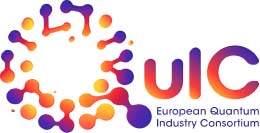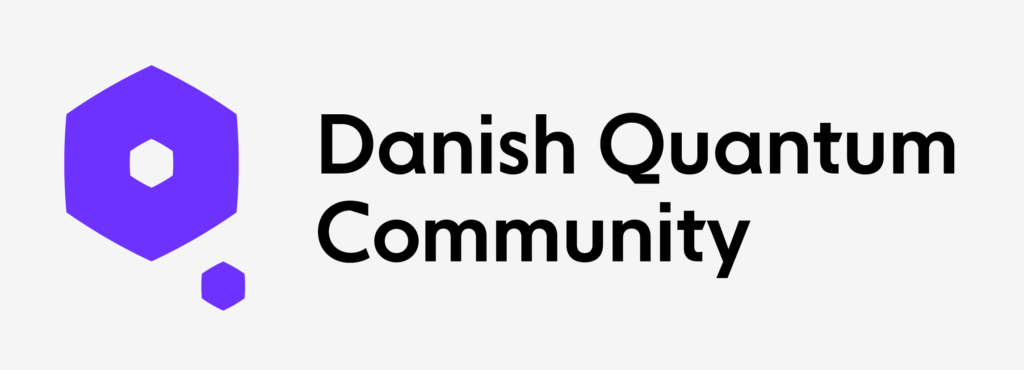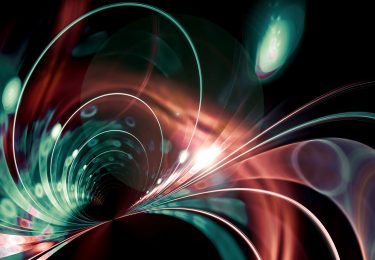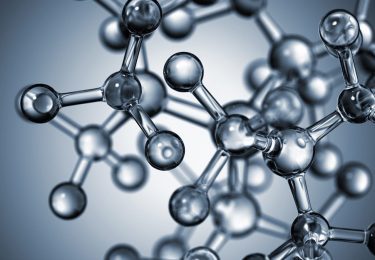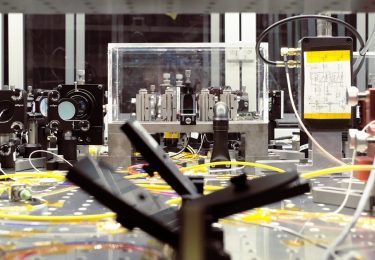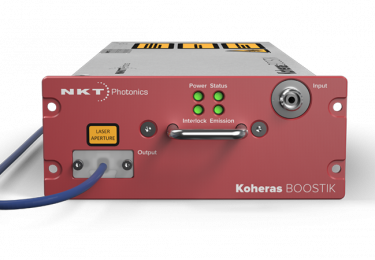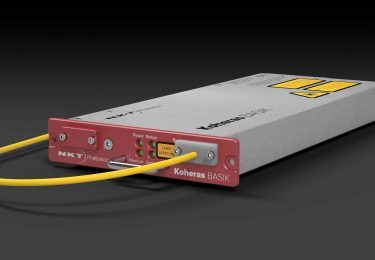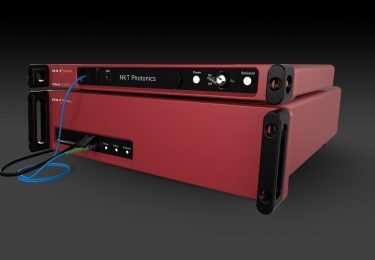Accurate quantum gravity sensors
Quantum gradiometers, gravity sensors, or gravimeters, allow you to accurately map local variations in gravity to ensure infrastructure integrity and safer constructions. They are great tools for, e.g., civil engineers, land surveyors, and railroad companies.
The most sensitive gravity sensors use atom interferometry on atoms cooled close to absolute zero and placed in a free fall. In a free fall, the distance traveled over a period of time is determined by the local gravitational pull.
You need accurate lasers to cool atoms
Laser cooling is a critical step that requires a tunable narrow-linewidth high-power laser such as our Koheras BASIK. Rubidium atoms are typically cooled in a magneto-optical trap, MOT. A MOT uses a combination of magnetic fields and a narrow-linewidth high-power laser at 780 nm to cool and trap the atoms and place them in an appropriate quantum state for further investigation by, e.g., atom interferometry.
We shoot light pulses at atoms as they undergo free fall. Each atom has a certain probability of absorbing a light pulse, and if it does, it slows down. The atoms that are slowed down do not travel as far as those not slowed down, which leads to two vertically separated outcomes with a relative distance determined by the gravitational pull.
Rubidium atoms are often used in gravitational sensors. If you carefully observe the free-fall acceleration, you can determine the local gravity and reveal even the tiniest variations created by dense objects or underground cavities.
Pick a stable laser
When you look for a laser for a gravitational sensing system, pick a stable one. The system will be moved around a lot and must keep its stability and precision. A fiber laser is a good choice because it contains no moving parts and is intrinsically stable.
The Koheras DFB fiber lasers are well known for their unmatched Hz-level linewidth at watt-power levels. But DFB fiber lasers only come in a few infrared wavelength bands. And these bands rarely match the wavelengths needed for laser cooling of atoms and ions.
Frequency conversion gives you 780 nm
We suggest seeding an Erbium-Doped Fiber Amplifier (EDFA), such as the Koheras BOOSTIK HP, with a stable narrow linewidth seed laser such as the Koheras BASIK at 1560 nm. Use the Koheras HARMONIK frequency conversion module to efficiently convert the high-power light at 1560 nm into high-power light at 780 nm.
You get a 780 nm fiber laser system at watt level with a beam quality M2 ≈ 1.1 and a free-running linewidth less than 1 kHz – the ideal laser system for any Rb atom interferometer.
Frequency conversion is a nonlinear process. The HARMONIK frequency conversion module only converts the main laser signal while cleaning up any unwanted power at out-of-band wavelengths present in most lasers.
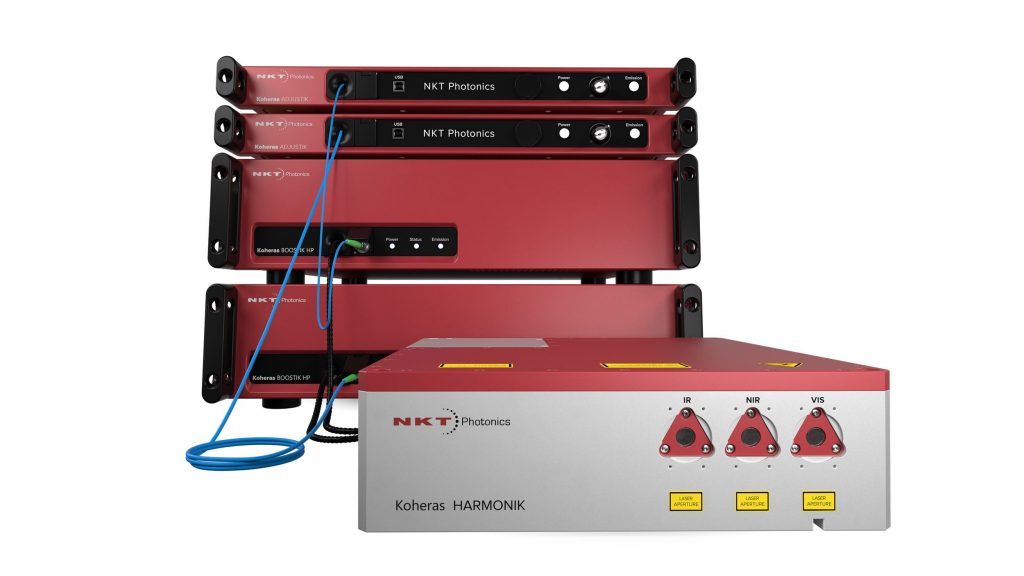
Robust enough for oil rigs yet sophisticated enough for the lab
Our fiber laser design is inherently compact and robust. It is developed for a lifetime of above 10 years in demanding environments where uptime is critical. With failure rates lower than 1%, we proudly deliver the most reliable low-noise lasers on the market. Alignment-free and maintenance-free.
The industrial-grade OEM lasers have a rugged design, a stable performance unaffected by changing environmental conditions, and wide temperature ranges in the field as well as the lab. We deliver lasers to the most advanced laboratories worldwide such as the UK Quantum Technology Hub for Sensors and Timing at the University of Birmingham and the Institute of Quantum Optics at Leibniz University Hannover.
We have more than 15,000 Koheras lasers deployed in the harshest environments on – and off – the planet. We have lasers on oil rigs, submarines, wind turbines, and even in space. With over 20 years of experience, we know they last. Also in your lab.
References
- Quantum sensing for gravity cartography by Ben Stray, Andrew Lamb, Aisha Kaushik, Jamie Vovrosh, Anthony Rodgers, Jonathan Winch, Farzad Hayati, Daniel Boddice, Artur Stabrawa, Alexander Niggebaum, Mehdi Langlois, Yu-Hung Lien, Samuel Lellouch, Sanaz Roshanmanesh, Kevin Ridley, Geoffrey de Villiers, Gareth Brown, Trevor Cross, George Tuckwell, Asaad Faramarzi, Nicole Metje, Kai Bongs, and Michael Holynski published in Nature 602, 2022.
- Twin-lattice atom interferometry by Martina Gebbe, Jan-Niclas Siemss, Matthias Gersemann, Hauke Müntinga, Sven Herrmann, Claus Lämmerzahl, Holger Ahlers, Naceur Gaaloul, Christian Schubert, Klemens Hammerer, Sven Abend, and Ernst M. Rasel published in Nature Communications, 2021.
- Optical frequency generation using fiber Bragg grating filters for applications in portable quantum sensing by Calum D. Macrae, Kai Bongs, and Michael Holynski published in Optics Letters, 46, 2021.
- Stabilized laser systems at 1550 nm wavelength for future gravitational wave detectors by Fabian Meylahn and Benno Willke, Max-Planck-Institut für Gravitationsphysik (Albert-Einstein-Institut) and Institut für Gravitationsphysik, Leibniz Universität Hannover, 2021.
- Doppler Compensated Cavity For Atom Interferometry by Rustin Nourshargh, Sam Hedges, Mehdi Langlois, Kai Bongs, and Michael Holynski in Atomic Physics, 2020.
- Performance of an optical single-sideband laser system for atom interferometry by Clemens Rammeloo, Lingxiao Zhu, Yu-Hung Lien, Kai Bongs, and Michael Holynski published in Journal of the Optical Society of America B, 2020.
- Taking atom interferometric quantum sensors from the laboratory to real-world applications by Kai Bongs, Michael Holynski, Jamie Vovrosh, Philippe Bouyer, Gabriel Condon, Ernst Rasel, Christian Schubert, Wolfgang P. Schleich, and Albert Roura published in Nature Reviews Physics, 2019.
- Application of optical single-sideband laser in Raman atom interferometry by Lingxiao Zhu, Yu-Hung Lien, Andrew Hinton, Alexander Niggebaum, Clemens Rammeloo, Kai Bongs, and Michael Holynski published in Opt. Express 26, 6542-6553, 2018.
- A portable magneto-optical trap with prospects for atom interferometry in civil engineering by A. Hinton, M. Perea-Ortiz, J. Winch, J. Briggs, S. Freer, D. Moustoukas, S. Powell-Gill, C. Squire, A. Lamb, C. Rammeloo, B. Stray, G. Voulazeris, L. Zhu, A. Kaushik, Y.-H. Lien, A. Niggebaum, A. Rodgers, A. Stabrawa, D. Boddice, S. R. Plant, G. W. Tuckwell, K. Bongs, N. Metje, and M. Holynski published in Philosophical transactions of the Royal Society A, 2017.
Our quantum engagements
We are part of the European Quantum Flagship, the European Quantum Industry Consortium, the Quantum Economic Development Consortium, and the Danish Quantum Community.




